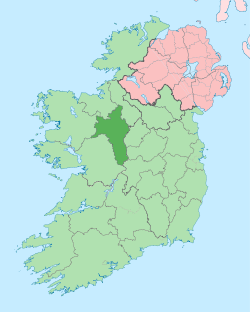Cootehall
| Cootehall Uachtar Thíre | |
|---|---|
| Village | |
|
New housing in Cootehall | |
 Cootehall Location in Ireland | |
| Coordinates: 53°59′04″N 8°09′30″W / 53.984471°N 8.158262°WCoordinates: 53°59′04″N 8°09′30″W / 53.984471°N 8.158262°W | |
| Country | Ireland |
| Province | Connacht |
| County | County Roscommon |
| Elevation[1] | 52 m (171 ft) |
| Time zone | WET (UTC+0) |
| • Summer (DST) | IST (WEST) (UTC-1) |
Cootehall (Irish: Uachtar Thíre, meaning "Upper Territory",[2] also Cloigne) is a village in County Roscommon, Ireland. It is located on the River Boyle, between Boyle and Carrick-on-Shannon near Lough Key Forest Park in the north of the county.
Cootehall lies 4 kilometres off the N4 road from Dublin to Sligo and between the R284 and R285 regional roads.
The Boyle River, which flows through Cootehall, connects the village with Lough Key to the west and the River Shannon to the east.
History
Cootehall was formerly called Urtaheera, or O'Mulloy's Hall, and was, early in the 17th century, together with the manor attached to it, the property of William, styled "the Great O'Mulloy ;" but in the war of 1641 it came into the possession of the English Cromwellian, Chidley Coote, nephew of the first Earl of Mountrath, and from that family took its present name.
Coothall (the house)
In the 17th and 18th century the house was built and occupied by the Coote family.
O'Carolan the famous piper is recorded as having visited the house and composed tunes for the occupants.
At some part of the 18th century the house was occupied by Maurice O'Connor. Was he an owner or a tenant?
In the 19th century Coothall was part of the Kilronan Castle Estate which belonged to the Tenison family. A detail survey of Coothall was made in 1862 for E.K. Tenison.[3]
The house at Coothall was occupied by Mr. Barton as a tenant of the Kilronan Estate.
Lady Louisa Tenison mentioned Coothall in her will of 1878 which is currently in the Irish National Archives.
The house survives to the present day.[4]
Suburban-style housing
The Fianna Fail government devised incentives for the 'development' of the midland counties. Unfortunately these incentives were not dovetailed into the County Council development plans which identified the scale of need for new housing. Cootehall was a hamlet until the 2000s when it experienced rapid growth during the Irish property bubble. It is now a large village in terms of the number of houses and shops existing - many of them had remain unoccupied from the time they were built in the mid-2000s until recently. Most of the houses are now occupied (Oct 2016).
From almost a decade it contained several ghost estates and was an archetypal example of the phenomenon.
People
- Writer John McGahern's father was based in the police station in Cootehall which inspired his novel The Barracks.
- The politician Seán Doherty was born and raised in Cootehall.
See also
Cootehall Barracks www.cootehallbarracks.com
